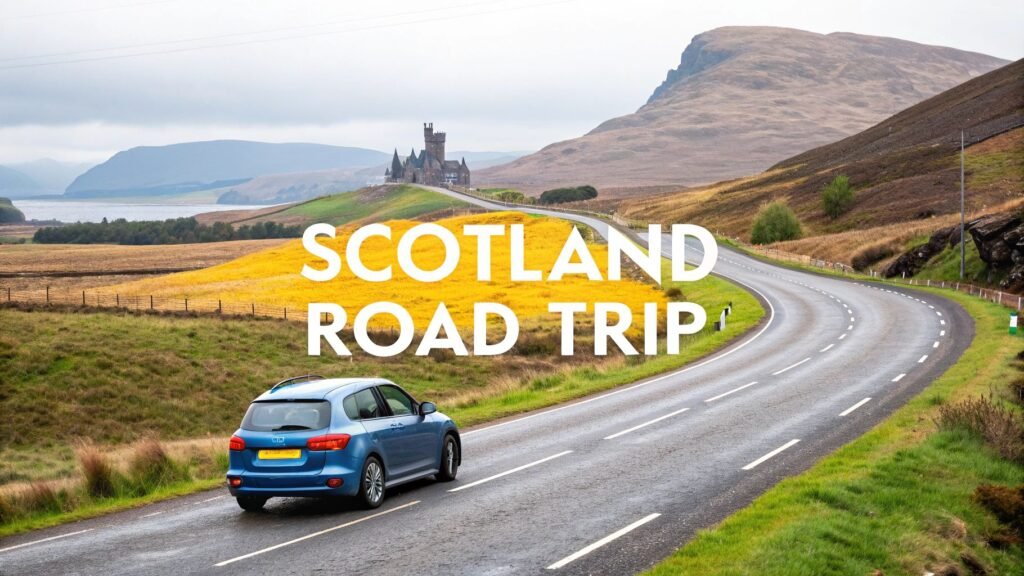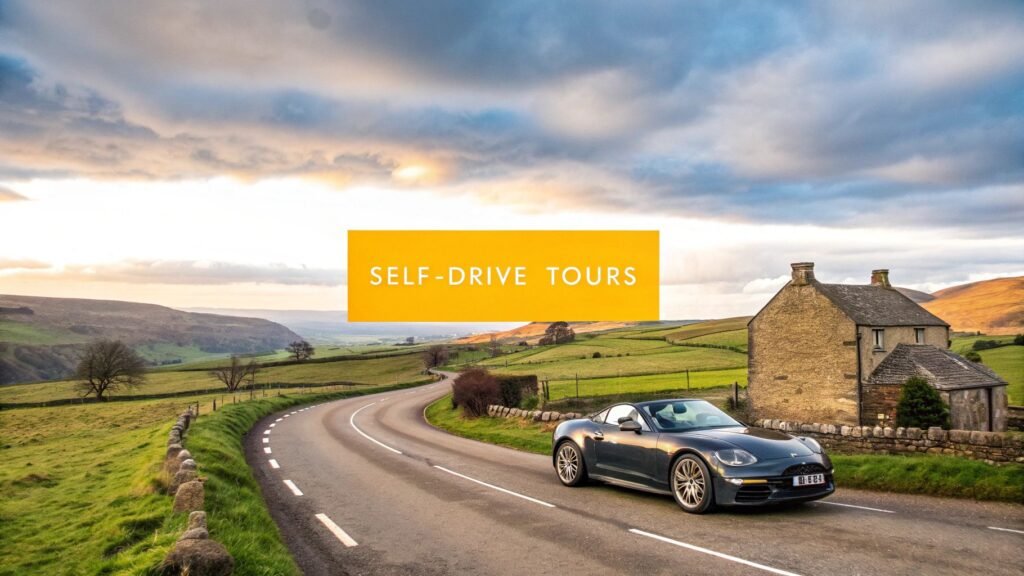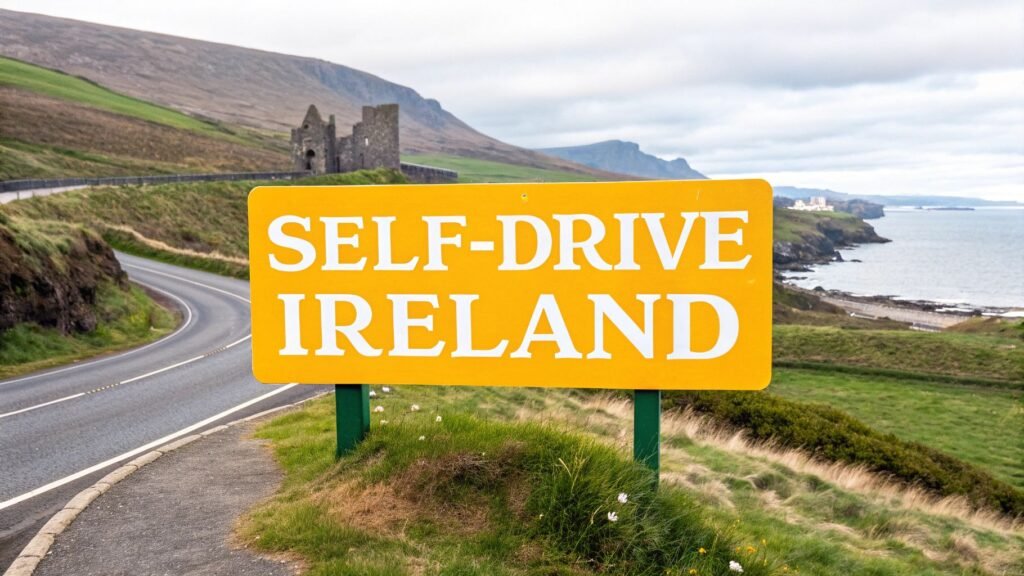From my experience, the best way to truly soak in Scotland is with a 14-day road trip itinerary loop. This gives you the perfect balance between seeing the iconic sights, such as Edinburgh’s historic streets, and getting lost in the wild, raw beauty of the Highlands and the Isle of Skye. A two-week trip lets you cover roughly 1,200 miles without feeling rushed, allowing plenty of time for those spontaneous detours to ancient castles and dramatic coastlines.
Your Essential Scotland Road Trip Blueprint
Figuring out a Scotland road trip can feel like trying to assemble a massive, beautiful jigsaw puzzle without the picture on the box. You’ve got all these incredible pieces—towering Munros, mysterious lochs, crumbling castles, and bustling cities—but how do they all fit together into a journey that makes sense?
This is where having a solid blueprint is a game-changer. It’s not about a rigid, minute-by-minute schedule, but a smart foundation for your adventure. A good plan ensures you hit Scotland’s absolute must-sees without the stress of wondering where to go next or the heartache of realizing you missed a hidden gem just around the corner. It’s all about balancing driving days with real exploration, pairing the famous landmarks with those quiet, off-the-beaten-path moments you’ll remember forever.
The Core Journey at a Glance
To give you a quick overview, this visual breaks down what a fantastic two-week trip looks like.
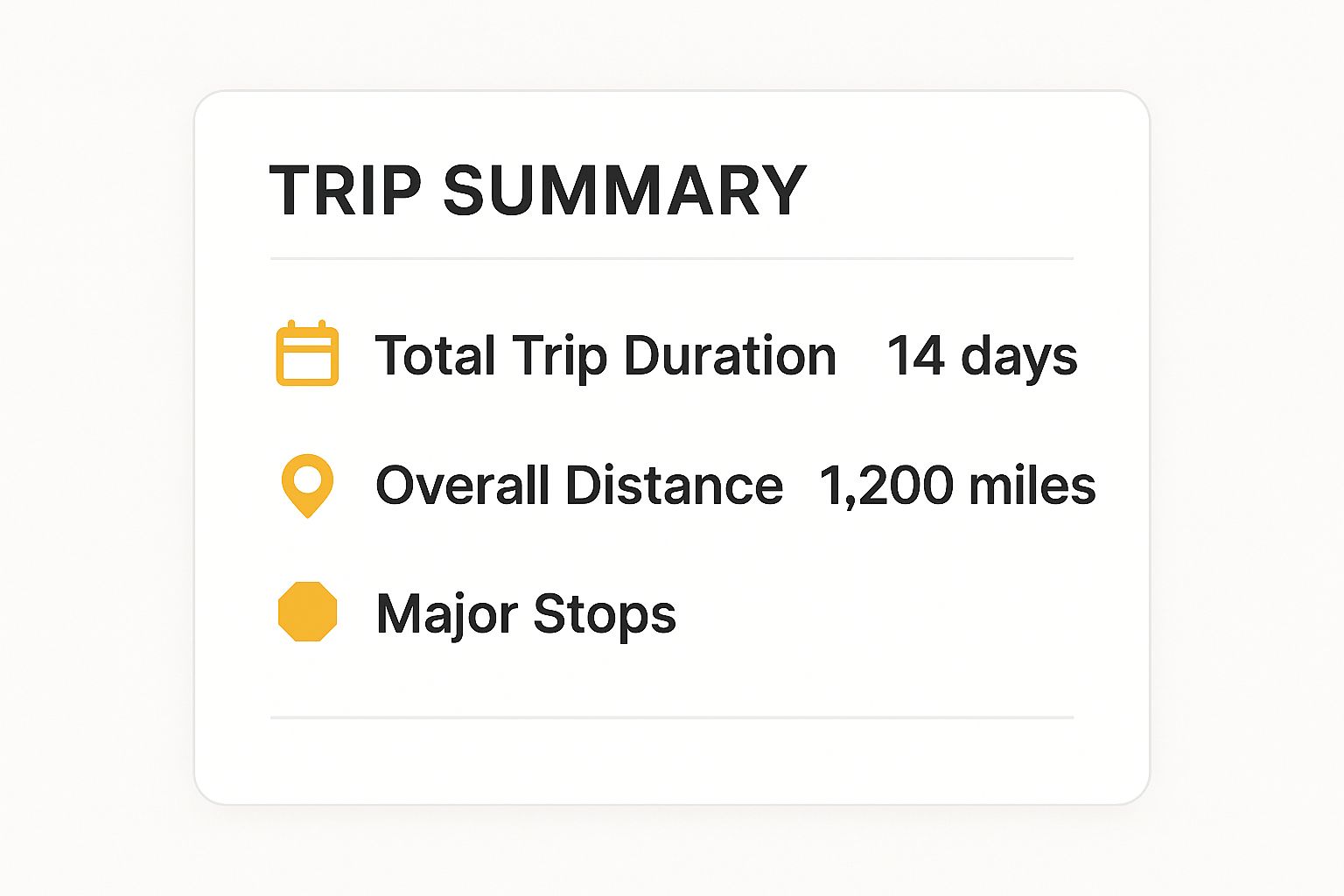
As you can see, 14 days is the sweet spot for hitting eight major stops over 1,200 miles—a pace that lets you explore deeply rather than just skim the surface.
Before we dive into the day-by-day details, let’s nail down a few key planning decisions. Getting these right from the start will make your entire trip smoother and more enjoyable.
Scotland Road Trip At a Glance
Here’s a quick summary table of the most important factors to consider as you begin planning. Think of this as your pre-trip checklist to make sure you’re set up for success.
| Planning Factor | Recommendation | Why It Matters |
|---|---|---|
| Best Time to Go | May, June, or September | You get the benefit of milder weather and longer daylight hours, but cleverly dodge the peak summer crowds and the infamous midges of July and August. |
| Ideal Vehicle | Compact or Mid-Size Car | Many of Scotland’s most scenic routes are B-roads and single-track lanes. A smaller car is infinitely easier to handle and park, especially in the Highlands. |
| Average Daily Budget | £150-£250 per person | This should comfortably cover mid-range lodging, food, fuel, and attraction tickets. Booking your big-ticket items early can bring this cost down. |
| Key Bookings | Accommodation & Ferries | I can’t stress this enough: popular spots on the Isle of Skye and the North Coast 500 get booked up months in advance. Securing these early is essential for a stress-free trip. |
Getting these four things sorted out first will take a huge weight off your shoulders, freeing you up to focus on the fun part—the adventure itself
What to Know Before You Go
A truly memorable Scotland road trip starts well before you ever get behind the wheel. Think of it like laying the groundwork for a grand adventure—getting a few key details sorted out first is what separates a good trip from an unforgettable one. These early decisions will shape your budget, your comfort, and how much you genuinely enjoy the journey.
First up: timing is everything. Scotland’s magic changes dramatically with the seasons. While summer brings long, bright days perfect for sightseeing, it also means peak crowds and prices. Honestly, for the best experience, I always recommend the “shoulder seasons” of May, June, or September. You’ll still get pleasant weather and nearly 16 hours of glorious daylight, but without fighting for space or dealing with the notorious Highland midges that descend in July and August.
Choosing Your Ride and Budget
Your choice of car is a bigger deal than you might think. A campervan sounds wonderfully romantic, but many of Scotland’s most breathtaking views are found down tiny B-roads and single-track lanes with passing places. A compact or mid-size car is just so much more practical. It makes navigating those tight corners and finding a parking spot in a charming little village a whole lot easier.
Next, let’s talk money. A realistic daily budget for a comfortable trip lands somewhere between £150-£250 per person. This should comfortably cover:
- Accommodation: Mid-range hotels, cozy B&Bs, or local guesthouses.
- Food & Drink: A delicious mix of pub dinners, cafe lunches, and maybe some self-catering.
- Fuel: This will be a significant cost, especially in the Highlands where petrol stations are fewer and prices are higher.
- Attractions: Entry fees for those must-see castles, distilleries, and museums.
Pro Tip: Book your accommodation and any ferry crossings (especially for places like Skye or the Outer Hebrides) months ahead of time. I can’t stress this enough. The best spots fill up incredibly fast, and just showing up hoping for a room is a recipe for disappointment, especially in high season.
Packing Smart and Supporting Locals
Once your main logistics are locked in, it’s time to think about packing. The weather here is famously fickle—layers are non-negotiable. Before you zip up your suitcase, check out some essential packing tips for travel will ensure you’re ready for sun, rain, and everything in between, sometimes all in the same day.
Finally, remember that your trip makes a real difference. Tourism is now the biggest employer in Scotland, supporting over 16,000 businesses and keeping around 245,000 people in work. By planning your route thoughtfully, you help spread the economic benefits to the rural communities that rely on visitors. It’s a wonderful way to ensure the spectacular landscapes you’ve come to see are protected for generations of adventurers to come.
The Classic 14-Day Scotland Itinerary
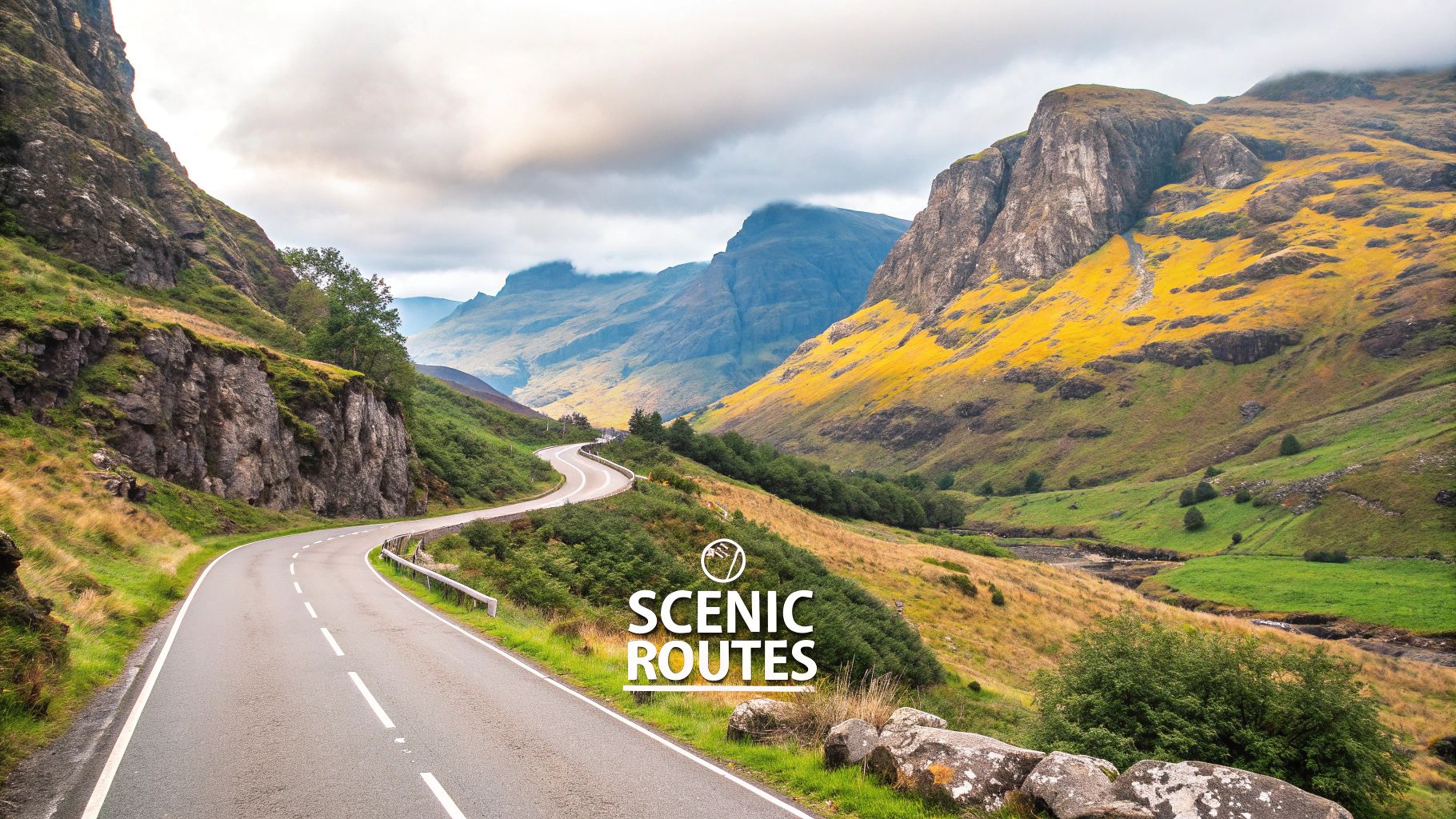
Alright, this is where the real adventure begins. We’ve put together a day-by-day plan that I think serves as the perfect roadmap for an unforgettable Scotland road trip itinerary. It’s been carefully designed to give you a bit of everything—the iconic city buzz, the wild and untamed Highlands, and the magic of the islands. It’s a true taste of what makes Scotland so special.
But here’s the thing: think of this less as a strict schedule and more as a flexible guide. Feel free to linger a little longer in a place that captures your heart or take a spontaneous detour down a promising-looking road. This plan is your launchpad for a journey filled with history, drama, and landscapes that will simply take your breath away.
Part 1: History, Drama, and the Highlands (Days 1-5)
Your journey kicks off in Scotland’s magnificent capital before you head north into landscapes so cinematic they feel like they’ve been pulled straight from a movie set.
- Days 1-2: Edinburgh’s Historic Heart: After arriving in Edinburgh, give yourself two full days to just soak it all in. Stroll the famous Royal Mile, starting from the regal Palace of Holyroodhouse and working your way up to the imposing Edinburgh Castle. Get lost in the narrow, winding closes, and for an unbeatable view, hike up Arthur’s Seat for a full panorama of the city.
- Days 3-4: The Glencoe Experience: It’s time to pick up your rental car and point it north toward the Highlands. The drive itself, which takes about 3 hours, is absolutely stunning. You’ll spend these next couple of days exploring the dramatic, sweeping valley of Glencoe, a place steeped in both tragic history and incredible natural grandeur. Hike some of the scenic trails, snap photos of the iconic “Three Sisters” mountains, and find the spots where scenes from James Bond and Harry Potter were filmed.
- Day 5: Fort William and the Road to Skye: From Glencoe, it’s a short drive to Fort William, a lively town nestled at the foot of Ben Nevis, the UK’s highest mountain. This is your jumping-off point for the legendary Road to the Isles toward Mallaig. You absolutely have to stop at the Glenfinnan Viaduct—especially if you’re a Harry Potter fan. It’s the perfect prelude to your island escape.
Part 2: Island Magic and Coastal Wonders (Days 6-10)
Now we trade the mainland mountains for the enchanting Isle of Skye and a taste of the world-famous North Coast 500.
- Days 6-8: The Magical Isle of Skye: Catch the ferry from Mallaig over to Armadale and prepare to spend three days exploring Skye’s almost otherworldly landscapes. You can hike to the mystical Fairy Pools, stand in awe of the Old Man of Storr, and drive the incredible Trotternish Peninsula loop to see Kilt Rock and the mind-bending Quiraing. The colourful harbor town of Portree makes an excellent base for your island adventures.
- Days 9-10: A North Coast 500 Taster: After crossing back to the mainland via the Skye Bridge, you’ll head north to tackle a condensed, but arguably most beautiful, section of the North Coast 500. The drive through Wester Ross is phenomenal, with its pristine white-sand beaches, unbelievably turquoise waters, and rugged, ancient mountains. Follow the route from Torridon up to the fishing port of Ullapool to experience the best of the NC500 without committing to the full 516 miles.
Part 3: The Journey South (Days 11-14)
Your final days will guide you back south through the heart of Scotland, taking in a world-famous loch and another historic city before you head home. If this two-week plan feels a bit too long, our Taste of Scotland 8-Days Self Drive Tour offers a more condensed but equally thrilling adventure.
- Day 11: Inverness and Loch Ness: From Ullapool, make your way to Inverness, the capital of the Highlands. In the afternoon, it’s time to explore the shores of the one and only Loch Ness. A visit to Urquhart Castle provides stunning views over the water, and of course, you have to keep an eye out for Nessie. You never know!
- Days 12-14: Stirling and Departure: Head south toward the historic city of Stirling, perhaps taking a scenic detour through the vast Cairngorms National Park. Spend a day exploring Stirling Castle, a pivotal fortress in Scottish history, and the nearby Wallace Monument. On Day 14, enjoy one last hearty Scottish breakfast before making the easy drive back to Edinburgh for your flight home, your head filled with incredible memories.
Conquering the North Coast 500
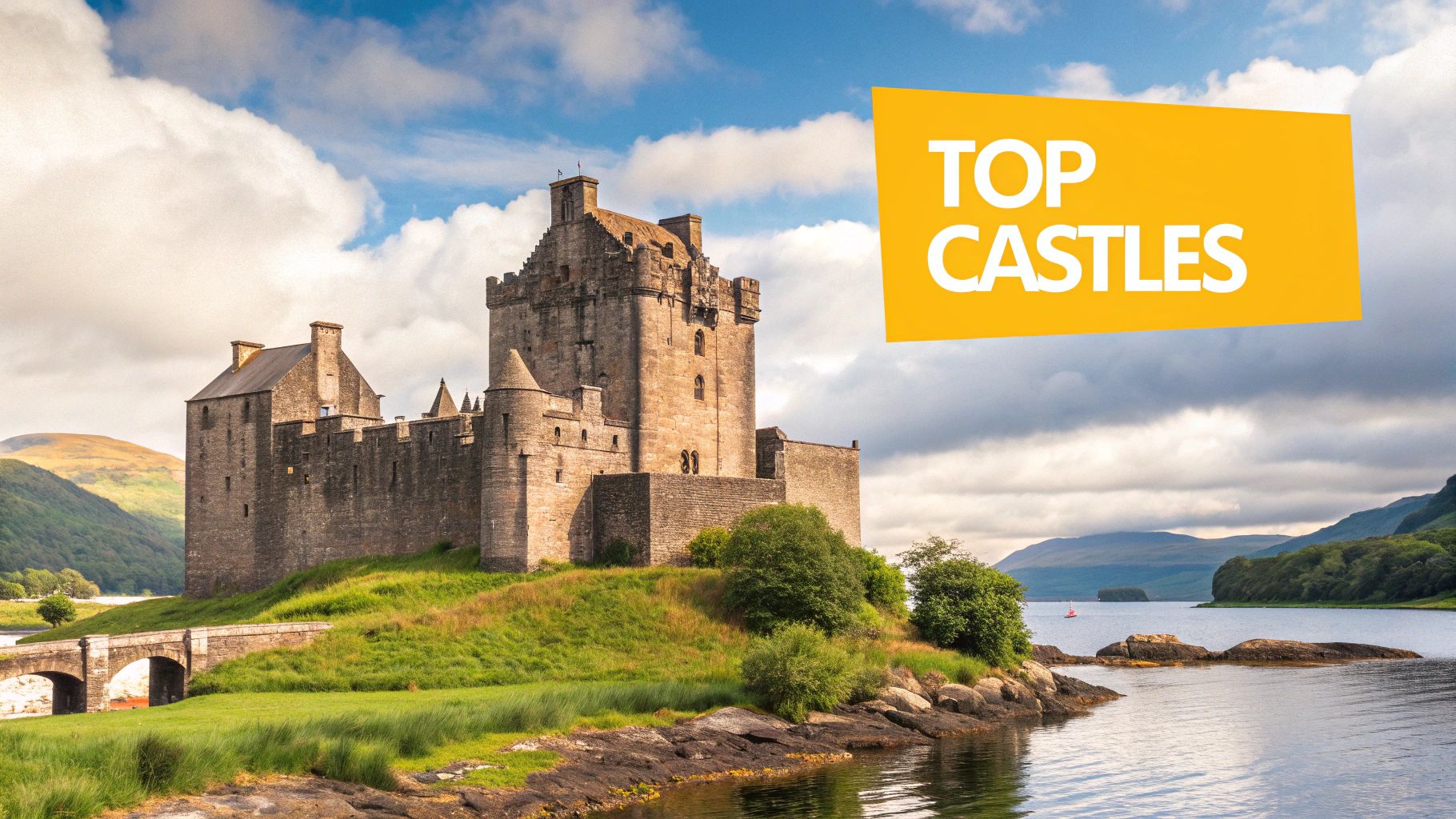
The North Coast 500 isn’t just a road trip; it’s a rite of passage. This legendary route, often called Scotland’s answer to Route 66, covers 516 miles of breathtaking tarmac, making it the undisputed crown jewel of any proper Scotland road trip itinerary. It’s a journey that loops around the raw, wild coastlines of the northern Highlands, starting and ending in the spirited city of Inverness.
Think of it as Scotland’s ultimate scenic drive. The NC500 will lead you through the cinematic landscapes of Wester Ross, across the vast, empty beauty of Sutherland, and along the historic shores of Caithness. It’s a drive that commands your full attention and a bit of planning, but believe me, the rewards are immense—views that steal your breath, beaches that look like they belong in the Caribbean, and castles straight out of a storybook.
Planning Your NC500 Drive
Right off the bat, you have a big decision to make: clockwise or anti-clockwise? You can do it either way, but my advice is to go clockwise. Heading west out of Inverness towards Applecross first builds the drama perfectly. You’re thrown right into some of the most staggering coastal scenery at the very beginning, setting an incredible tone for the rest of the drive.
Speaking of Applecross, you’ll quickly face one of the route’s most famous—and infamous—challenges: the Bealach na Bà, or “Pass of the Cattle.” This is proper white-knuckle driving. As one of the UK’s steepest mountain passes, it throws tight hairpin bends and gradients of up to 20% at you. It’s an absolute thrill, but it’s not for nervous drivers or large motorhomes. If that sounds like too much, don’t worry—there’s a much easier, clearly marked alternative route along the A896.
Single-Track Etiquette and Responsible Travel
A huge part of the NC500 experience involves navigating single-track roads. Getting the hang of these is the secret to a relaxed and enjoyable trip. The system is straightforward but vital for keeping traffic moving in these remote parts.
- Passing Places: These are your best friends. Use these designated pull-ins to let faster cars by or to allow oncoming traffic to pass. The golden rule? The vehicle closest to a passing place is the one that pulls in.
- Giving Way: Always pull into a passing place on your left. If the passing place is on your right-hand side, stop on your side of the road, opposite the space, to let the other driver pull into it.
- The NC500 Wave: A simple, friendly wave to say thanks to drivers who pull over for you is standard practice. It’s a small bit of Highland courtesy that makes a big difference.
The NC500 is more than just a stunning drive; it’s a living, breathing community. Its popularity has brought incredible benefits but also real pressure on the local environment and infrastructure. This is your chance to be a thoughtful visitor.
The route’s fame has put a spotlight on the need for mindful tourism. After all, the road winds through some of the most fragile and beautiful landscapes in the Highlands. A recent initiative saw nearly 3,000 tourists pledge to protect Scotland’s most famous road trip by travelling responsibly. Adopting this mindset—supporting local businesses, leaving no trace, and respecting the communities—ensures the NC500 will continue to be an incredible experience for generations to come.
Beyond the NC500: Discovering Scotland’s Hidden Routes
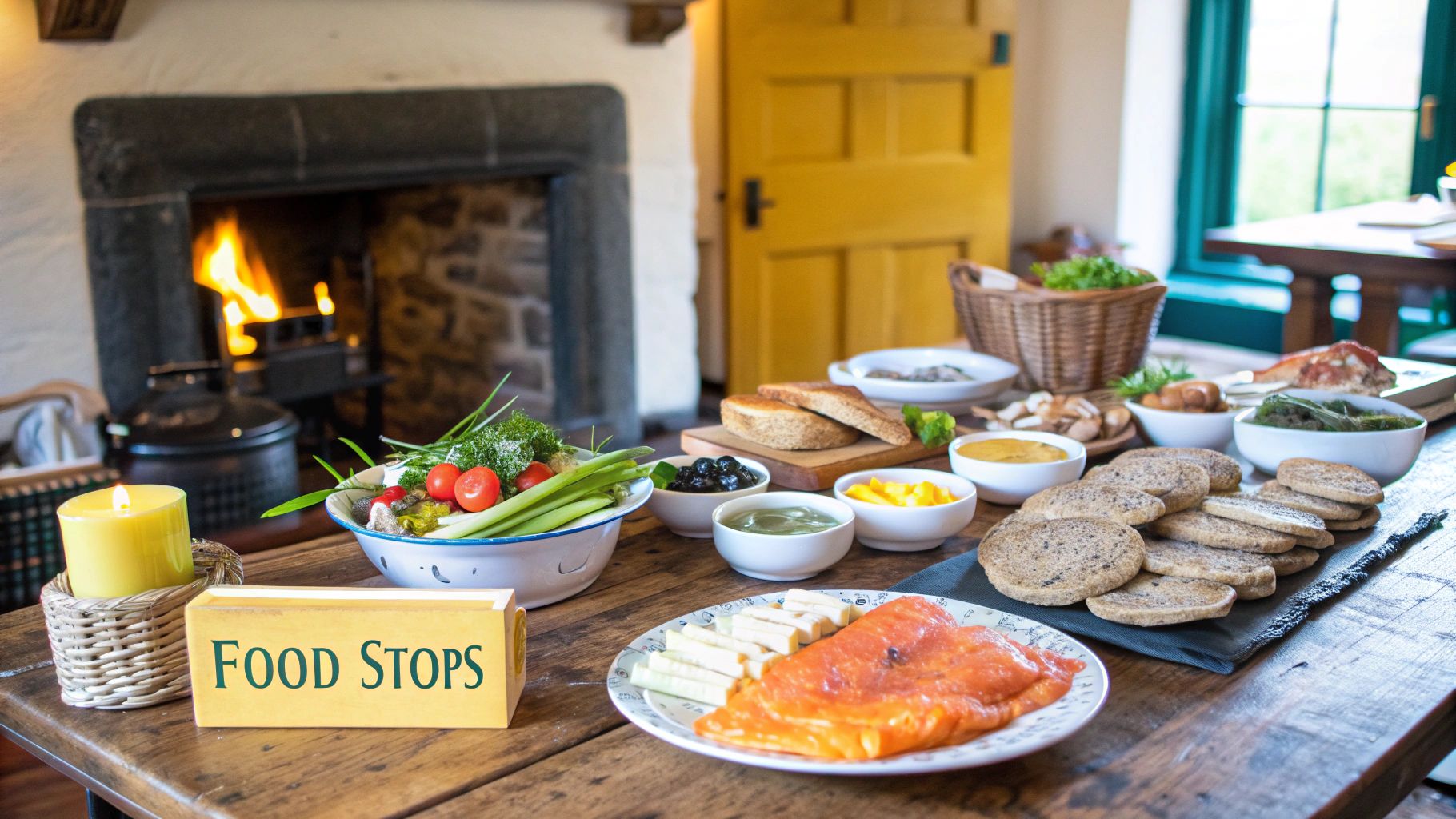
The North Coast 500 gets a lot of love, and for good reason. But what if I told you that some of Scotland’s most magical drives lie just off the beaten path? If you’re willing to skip the well-trodden tourist trail, you’ll discover a quieter, more personal side of the country. This is your chance to trade the traffic for tranquility and find a piece of Scotland that feels truly yours.
Think of these alternative routes as the B-sides to a classic album—not the chart-topping hits, but often where the real gems are hidden. They take you through regions with their own distinct personalities, from the castle-strewn coastlines of the northeast to the lush, green heart of the nation.
The North East 250: Castles and Whisky Galore
If you’re a history lover or a whisky connoisseur, the North East 250 is an absolute dream. This fantastic circular route winds its way through Aberdeenshire, a region that famously has more castles per acre than anywhere else in the UK. Just picture it: one morning, you’re exploring the jaw-dropping ruins of Dunnottar Castle perched on a cliff, and by the afternoon, you’re sampling a dram at a world-class distillery in Speyside.
You’ll love this drive if you’re looking for:
- Epic History: The route connects over a dozen of Scotland’s most breathtaking castles.
- Stunning Coastlines: You’ll cruise along the rugged Moray Firth coast, dotted with postcard-perfect fishing villages and windswept beaches.
- The Water of Life: The road cuts straight through Speyside, home to more than half of all of Scotland’s malt whisky distilleries.
The Heart 200 and South West Coastal 300
For those whose ideal Scotland road trip itinerary is all about peaceful lochs and enchanting forests, the Heart 200 is a perfect fit. This 200-mile loop is centred around Perthshire and the Trossachs National Park, offering a landscape that’s a bit gentler but every bit as beautiful. It’s a fantastic choice for anyone keen on hiking, kayaking, or simply finding a cozy town to settle into for a few days.
On these quieter roads, you get a much more authentic feel for local life. You’re not just ticking off sights; you’re tapping into the real rhythm of Scotland, from lively market towns to serene glens where Gaelic culture is still woven into the fabric of the community.
Or, for a different kind of adventure, the South West Coastal 300 (SWC300) is Scotland’s answer to Ireland’s dramatic coastal roads. This route dives into the often-overlooked region of Dumfries and Galloway, serving up a spectacular blend of jagged cliffs, sandy coves, and rolling green farmland. It’s a drive for those who want to feel like they’ve stumbled upon a brilliant secret.
If you’re kicking off your trip from the capital, a great way to start is by soaking up the history in Edinburgh, the Athens of the North, before setting off on one of these less-traveled adventures.
Essential Tips for Driving in Scotland
Getting behind the wheel in Scotland is where the real adventure begins. But it’s a different world from your daily commute, with its own rhythm and unwritten rules. Nailing these is the secret to a smooth, incredible trip through the Highlands. Think of these tips as your local co-pilot, giving you the confidence to tackle any road.
First up, the famous (and sometimes infamous) single-track roads. You’ll find them all over the Highlands and islands. They’re exactly what they sound like: a single lane for traffic going in both directions, made manageable by a simple, courteous system.
The magic ingredient is the passing place. These are little pull-offs you’ll see every couple of hundred yards. The golden rule is that whichever car is closest to a passing place should be the one to pull in and let the other vehicle pass. It’s a dance of cooperation.
Navigating Single-Track Roads
Here’s how you handle them like you’ve been doing it for years:
- Pull in on your left: If a passing place is on your left, pull into it. Simple as that.
- Stop for others: If the passing place is on your right, stop on your side of the road, directly opposite the pull-in. This gives the oncoming car room to swing into the space and get around you.
- Give a wee wave: This is non-negotiable! A quick wave to the driver who pulled over for you is classic Highland etiquette. It’s a small thank you that keeps things friendly.
My most critical piece of advice? Never trust the drive times you see on Google Maps. It’s wildly optimistic for rural Scotland. A 50-mile journey on a winding A-road or a single-track lane can easily take over 90 minutes.
Preparing for the Unexpected
Beyond the roads, you have to be ready for Scotland’s beautiful but unpredictable personality. This means being prepared for sudden weather shifts and the practical challenges of being in a remote area.
For instance, fuel stations can become a rare sight once you’re deep in the countryside. I have a personal rule: never let the tank drop below half-full. If you see a petrol station, top up. Don’t risk it, even if you think you have enough for the next leg.
It’s the same story with mobile service, which can vanish completely in the glens. Always download your maps for offline use before you leave your hotel each morning.
This mindset—planning ahead and driving with awareness—is what makes a good trip great. If you’d rather have an itinerary that already accounts for all these quirks, take a look at our expertly planned self-drive tours. We build in plenty of breathing room for safe, scenic, and stress-free driving.
Got Questions? Let’s Get Them Answered
Even the most meticulously planned Scotland adventure comes with a few last-minute questions. It’s completely normal. Let’s tackle some of the common things that might be on your mind so you can hit the road feeling confident and ready for anything.
So, when should you actually go? While the summer months have their appeal, my personal recommendation is to aim for May, June, or September. You get the magic of long days and generally pleasant weather, but you’ll cleverly sidestep the worst of the summer crowds and, crucially, the notorious Highland midges.
Talking Money and Getting Behind the Wheel
I often get asked about a realistic daily budget. A solid starting point is to plan for around £100 to £150 per person, per day. This will comfortably cover a nice B&B or mid-range hotel, meals, fuel, and tickets for most castles and sights you’ll want to see.
Worried about driving on the left? I get it. The key is to take it easy on your first day. Avoid jumping straight into a busy city like Glasgow or Edinburgh. Give yourself time to adapt on the quieter country roads – you’ll find they’re often nearly empty, giving you all the space you need to get the hang of it.
And what about the car itself? Do you need a big 4×4 to conquer the Highlands? Honestly, no. For 99% of road trips, a standard compact or mid-size car is perfectly fine. In fact, a smaller car is a huge advantage on those classic, narrow single-track roads and a lifesaver when trying to park in a tiny fishing village. It just makes the whole experience far less stressful.

